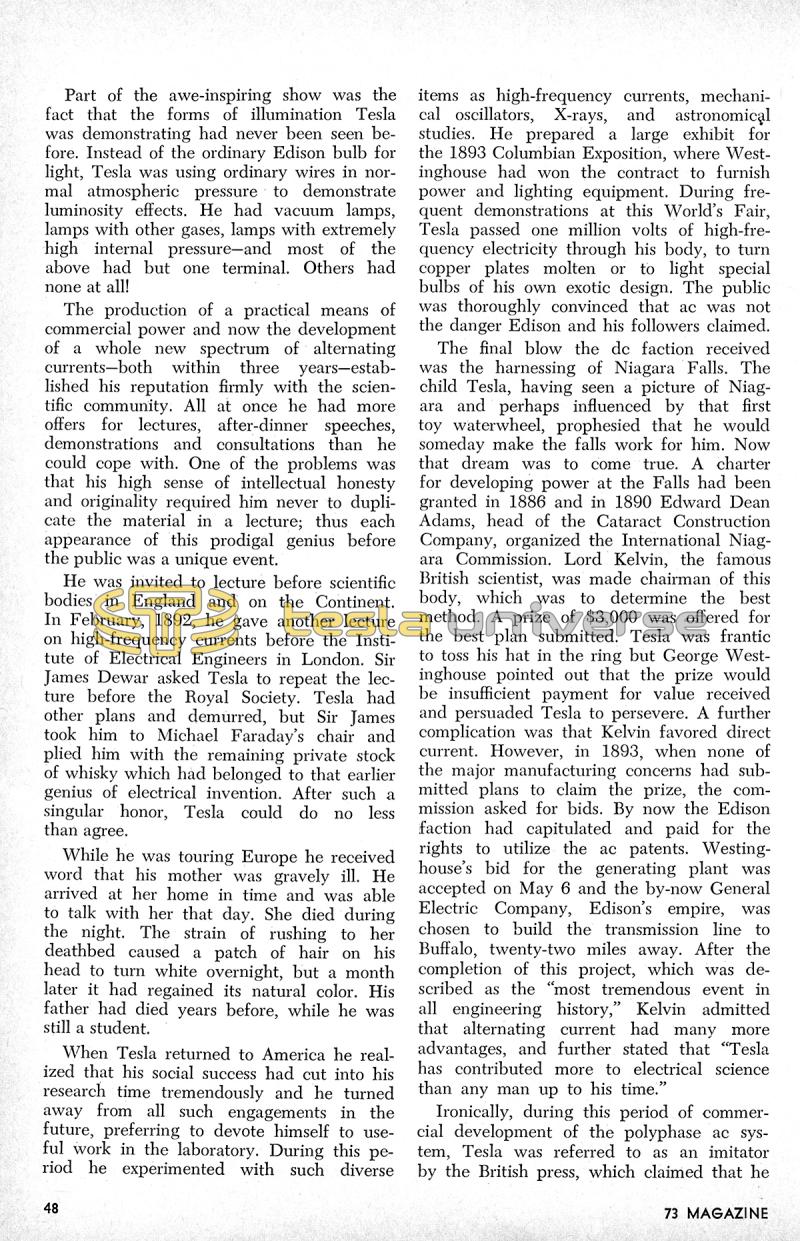
Nikola Tesla Articles
Part of the awe-inspiring show was the fact that the forms of illumination Tesla was demonstrating had never been seen before. Instead of the ordinary Edison bulb for light, Tesla was using ordinary wires in normal atmospheric pressure to demonstrate luminosity effects. He had vacuum lamps, lamps with other gases, lamps with extremely high internal pressure-and most of the above had but one terminal. Others had none at all!
The production of a practical means of commercial power and now the development of a whole new spectrum of alternating currents-both within three years-established his reputation firmly with the scientific community. All at once he had more offers for lectures, after-dinner speeches, demonstrations and consultations than he could cope with. One of the problems was that his high sense of intellectual honesty and originality required him never to duplicate the material in a lecture; thus each appearance of this prodigal genius before the public was a unique event.
He was invited to lecture before scientific bodies in England and on the Continent. In February, 1892, he gave another lecture on high-frequency currents before the Institute of Electrical Engineers in London. Sir James Dewar asked Tesla to repeat the lecture before the Royal Society. Tesla had other plans and demurred, but Sir James took him to Michael Faraday's chair and plied him with the remaining private stock of whisky which had belonged to that earlier genius of electrical invention. After such a singular honor, Tesla could do no less than agree.
While he was touring Europe he received word that his mother was gravely ill. He arrived at her home in time and was able to talk with her that day. She died during the night. The strain of rushing to her deathbed caused a patch of hair on his head to turn white overnight, but a month later it had regained its natural color. His father had died years before, while he was still a student.
When Tesla returned to America he realized that his social success had cut into his research time tremendously and he turned away from all such engagements in the future, preferring to devote himself to useful work in the laboratory. During this period he experimented with such diverse items as high-frequency currents, mechanical oscillators, X-rays, and astronomical studies. He prepared a large exhibit for the 1893 Columbian Exposition, where Westinghouse had won the contract to furnish power and lighting equipment. During frequent demonstrations at this World's Fair, Tesla passed one million volts of high-frequency electricity through his body, to turn copper plates molten or to light special bulbs of his own exotic design. The public was thoroughly convinced that ac was not the danger Edison and his followers claimed.
The final blow the dc faction received was the harnessing of Niagara Falls. The child Tesla, having seen a picture of Niagara and perhaps influenced by that first toy waterwheel, prophesied that he would someday make the falls work for him. Now that dream was to come true. A charter for developing power at the Falls had been granted in 1886 and in 1890 Edward Dean Adams, head of the Cataract Construction Company, organized the International Niagara Commission. Lord Kelvin, the famous British scientist, was made chairman of this body, which was to determine the best method. A prize of $3,000 was offered for the best plan submitted. Tesla was frantic to toss his hat in the ring but George Westinghouse pointed out that the prize would be insufficient payment for value received and persuaded Tesla to persevere. A further complication was that Kelvin favored direct current. However, in 1893, when none of the major manufacturing concerns had submitted plans to claim the prize, the commission asked for bids. By now the Edison faction had capitulated and paid for the rights to utilize the ac patents. Westinghouse's bid for the generating plant was accepted on May 6 and the by-now General Electric Company, Edison's empire, was chosen to build the transmission line to Buffalo, twenty-two miles away. After the completion of this project, which was described as the "most tremendous event in all engineering history," Kelvin admitted that alternating current had many more advantages, and further stated that "Tesla has contributed more to electrical science than any man up to his time."
Ironically, during this period of commercial development of the polyphase ac system, Tesla was referred to as an imitator by the British press, which claimed that he
